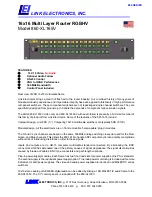
48-2
Catalyst 4500 Series Switch, Cisco IOS Software Configuration Guide - Cisco IOS XE 3.9.xE and IOS 15.2(5)Ex
Chapter 48 Configuring MACsec Encryption
Understanding Media Access Control Security and MACsec Key Agreement
Note
For more information, refer to the
Cisco TrustSec Switch Configuration Guide
:
http://www.cisco.com/en/US/docs/switches/lan/trustsec/configuration/guide/trustsec.html
For complete syntax and usage information for the switch commands used in this chapter, see the
Cisco IOS Command Reference Guides for the Catalyst 4500 Series Switch
.
If a command is not in the
Cisco Catalyst 4500 Series Switch Command Reference
, you can locate it in
the
Cisco IOS Master Command List, All Releases
.
Understanding Media Access Control Security
and MACsec Key Agreement
MACsec, defined in 802.1AE, provides MAC-layer encryption over wired networks by using
out-of-band methods for encryption keying. The MACsec Key Agreement (MKA) Protocol provides the
required session keys and manages the required encryption keys. MKA and MACsec are implemented
after successful authentication using the 802.1X Extensible Authentication Protocol (EAP) and
EAP-Transport Layer Security (EAP-TLS) framework. MKA MACsec supports both host facing links
(links between network access devices and endpoint devices such as a PC or IP phone) and
switch-to-switch links, beginning in Cisco IOS Release 15.2(5)E and Cisco IOS XE Release 3.9.0E.
A switch using MACsec accepts either MACsec or non-MACsec frames, depending on the policy
associated with the client. MACsec frames are encrypted and protected with an integrity check value
(ICV). When the switch receives frames from the client, it decrypts them and calculates the correct ICV
by using session keys provided by MKA. The switch compares that ICV to the ICV within the frame. If
they are not identical, the frame is dropped. The switch also encrypts and adds an ICV to any frames sent
over the secured port (the access point used to provide the secure MAC service to a client) using the
current session key.
The MKA Protocol manages the encryption keys used by the underlying MACsec protocol. The basic
requirements of MKA are defined in 802.1X-2010. The MKA Protocol extends 802.1X to allow peer
discovery with confirmation of mutual authentication and sharing of MACsec secret keys to protect data
exchanged by the peers.
Pre-shared keys (PSKs) are used to generate Connectivity Association Keys (CAKs). In symmetric
cryptography, PSK means a key or a shared secret. This key is shared between parties before it is used.
The PSK is used to generate the Key Encryption Key (KEK) and the integrity check value (ICV) Key
(ICK).
In a switch-to-switch connection using the PSK, there is no concept of the authenticator, because of the
EAP authentication on the switch. So the switch with highest priority becomes the Key Server (KS). In
the current implementation, MKA can act as a non-KS without much change, except for accepting the
PSK instead of the CAK.
The EAP framework implements MKA as a newly defined EAP-over-LAN (EAPOL) packet. EAP
authentication produces a master session key (MSK) shared by both partners in the data exchange.
Entering the EAP session ID generates a secure connectivity association key name (CKN). Because the
switch is the authenticator, it is also the key server, generating a random 128-bit secure association key
(SAK), which it sends it to the client partner. The client is never a key server and can only interact with
a single MKA entity, the key server. After key derivation and generation, the switch sends periodic
transports to the partner at a default interval of 2 seconds.
The CAK and CKN will be derived from the configured PSK name and value
Summary of Contents for Catalyst 4500 Series
Page 2: ......
Page 4: ......
Page 2086: ...Index IN 46 Software Configuration Guide Release IOS XE 3 9 0E and IOS 15 2 5 E ...
















































